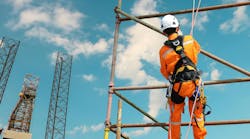OSHA’s rules for scaffolding are in 29CFR1926, Subpart L. This runs a little less than seven pages, and the rules apply to employers. Since as a group employers don’t do so well with compliance (though some individual employers do very well with compliance), in general the scaffold user should assume personal responsibility for scaffolding safety. Follow these six steps to safely use scaffolding.
Step No. 1 — Prepare the site
This includes several actions:
- Barricade it off. Yellow barricade tape means go around or enter with caution, while red barricade tape means do no enter. Putting up signage to create a detour will also help.
- Prep the surface. Ensure the surface is solid and level. This may require the use of boards, especially outdoors.
- Perform the necessary lockout/tagout. Scaffolds are, by definition, elevated platforms. Things fall from them, and so do people. Determine what should be de-energized below and around the scaffolding.
- Remove combustibles. What a terrible fate to be trapped on a scaffolding while toxic smoke from a fire below engulfs you. Don’t let that happen — either keep combustibles away or have a fire attendant standing by.
Step No. 2 — Assemble
Skip this step if scaffold assembly is done by a dedicated group. But if your crew is erecting the scaffolding, ensure the person in charge of that effort meets the OSHA definition of a “qualified person.” If you don’t know what you are doing, you can easily make a mistake that is fatal.
Step No. 3 — Inspect
If only one person is qualified to erect the scaffolding, it’s not smart to rely totally on that person to also inspect the scaffolding. A workaround is the lone qualified person explains to another crew member what to look for, and that person performs the inspection under the guidance of the qualified person. The idea is to have another set of eyes on the work, but it’s also good OJT for the unqualified person. Some things to look for:
- Scaffolding is level and aligned with the work to be performed.
- Clearances to overhead power lines are correctly observed.
- Sole plates are correctly positioned.
- Each joint is made with the correct connector.
- Each deck is properly secured. For example, no loose boards that can flip up or sideways.
Step No. 4 — Provide access
It’s not necessarily the case that you can climb the frame of a scaffold to move from deck to deck. Unless the frame is specifically designed to be climbed, ensure access ladders are installed. Also provide a means by which to raise and lower parts, tools, materials, instruments, etc., so that employees do not attempt to carry these while climbing the access ladders (or frame).
Step No. 5 — Tie off
While it may feel like you’re on level ground while standing on a scaffold platform, you are on an elevated platform. You could step off or fall off that platform, so wear a harness and attach the lanyard to an attachment point that is above your waist.
Step No. 6 — Keep platforms clear
Even if you are wearing fall protection, slipping on excess materials and falling off the platform can hurt. Use buckets or similar items to store parts, tools, and other loose items. Be continually vigilant against slipping and tripping hazards.
If your company has you on scaffolding frequently and you’re not a qualified person for erecting and inspecting it, speak with your supervisor about becoming qualified. You might also inquire about how the company complies with OSHA’s requirements; if nobody really knows, that could be a career opportunity for you in addition to being a safety opportunity.




